Isabella Viega and Rabbit Soup / Forest Elegies
This article will be the first in a series showcasing the amazing work that has been created using the Huskiana Printing Press in its first year up and running at Northeastern University. I had the opportunity to speak with Northeastern alumni Isabella Viega (they/them). We had the chance to talk about their experience using the press to create their poetry chapbook entitled Rabbit Soup / Forest Elegies with fellow author Alissa Lederer, and the impact that this project had on their academic, personal, and career interest with dead media and print culture.
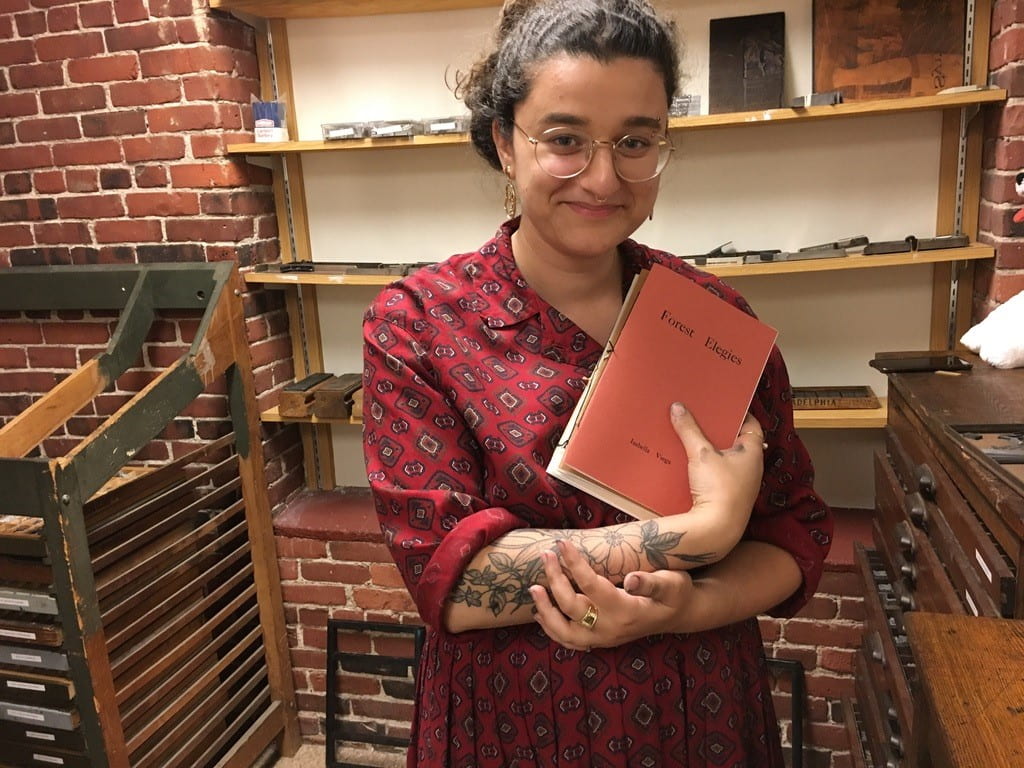
Where are you now and what are you up to?
I’m currently at Oxford getting my Masters in English Literature (1830-1914). My dissertation for my masters, I do Gender and Sexuality studies stuff, so I’m writing about Victorian women’s ghost stories and I’m like sort of exploring how the narratology of ghost stories is connected to gender discourse. But then I also have this other side where I’m really interested in the printing press and typewriters and stuff like that so sometimes they don’t seem to intersect but actually they do a lot because all of these texts we’re studying were initially printed with a printing press.
How did you first hear about the printing press on Northeastern’s campus?
Actually I took Ryan [Cordell]’s Technologies of Text class back in the Spring of 2018. And this was before he had the Golden Pearl press (AKA Huskiana) so I think he just had a few hand presses in that little weird closet room (English Department Holmes Hall). No one was using it so that’s when Ryan got permission to transform it into a make shift print shop. In the class I first made a little printed postcard using the hand press. He had mentioned that maybe in the next semester we’ll start a printing press club, and I was like f*** yea that sounds amazing. But after that I didn’t really hear anything about it for a while. And then he acquired the Pearl press and started getting all this furniture. And honestly I don’t know how I heard about it but I just ran into Ryan in random places and yea so
So you were just in the department, in the know?
Yea exactly.
What did you initially find interesting about the press or what fascinated you about the press itself?
That’s a really good question. I remember being really into it when we were doing the postcards in class and just finding it fascinating. But I think for me the biggest draw for them, I just really like revivifying forgotten and lost media forms. I like giving them second lives. And I think that they have a lot of power in literature, and the more I’ve studied printing presses and periodicals and serializations, you realize how central the printing press was to literature, and you really can’t remove the printing press from the text itself. I thought it was this incredible world that for me like I wanted to explore more, and it had such tangible connections to my interests and the world at large.
Yea totally. It’s like a direct, physical connection to history almost. Was this poetry book your first independent project in the press and how did it come about?
Yes, so it was kind of independent. My friend and I were in the same AWD class (Advanced Writing in the Disciplines) and we took actually a CAMD (College of Arts, Media, and Design) one, because, I don’t know why we were just so close to graduating and we were like whatever let’s do this one. And so we had this really open ended final project, I don’t even really remember the prompt but basically we could do anything, write an essay, a short story, whatever. And my friend and I both write poetry, and we knew about the printing press, so we thought we would just ask Ryan if we could use the printing press. It was technically for class but we honestly just wanted to do it for fun. So we got Ryan’s permission and we embarked on this crazy journey together.
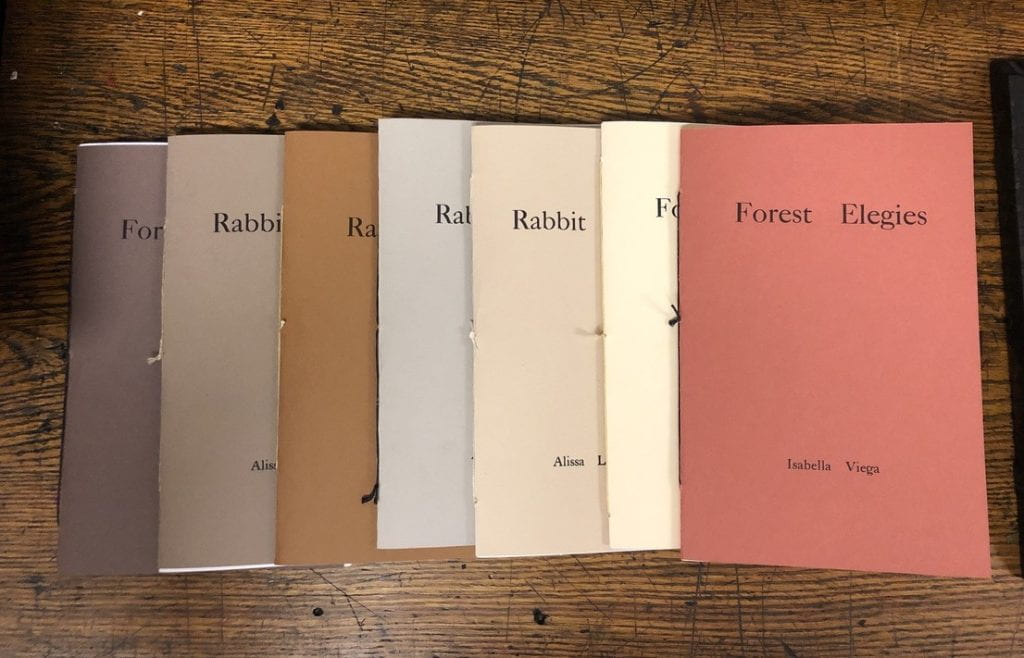
So you said you already wrote poetry with your friend, or you each wrote your own poetry. Could you walk us through the process of how you chose which poems to use, typesetting the book and the over all layout?
Absolutely, so we had a few poems we had already written. This was Spring 2019 semester, we had a weekly date after class where we would meet up and write together. We went in knowing we wanted to make a collaborative poetry book, but we were like how do we do this? We had never seen one before that was written by two different artists, how do we lay it out, how can our poems be in conversation with one another? But we noticed right away that our poems had very different tones. So we would workshop poems together and sometimes we scrapped a bunch of poems. It was really cathartic honestly, just like hanging out with my friend and making art together. We basically just picked which ones felt good.
How did the medium of the printing press affect your project?
A lot of what we decided to publish was dependent on the form as well. Alissa was in Scout (Design club at Northeastern), and she was talking to one of the people there about our project, explaining that we didn’t quite know how to format the booklet, and he came up with the idea that we could have an inverted form. So you read one half and then flip the text to read the other half. We thought that was the perfect way for our poems to be separate but also in conversation with one another. We settled on five poems for each of us. In the middle of the text we decided to do something collaborative in order to bridge the gap between our work, but we didn’t write the middle until we were typesetting the piece in the printing press studio.
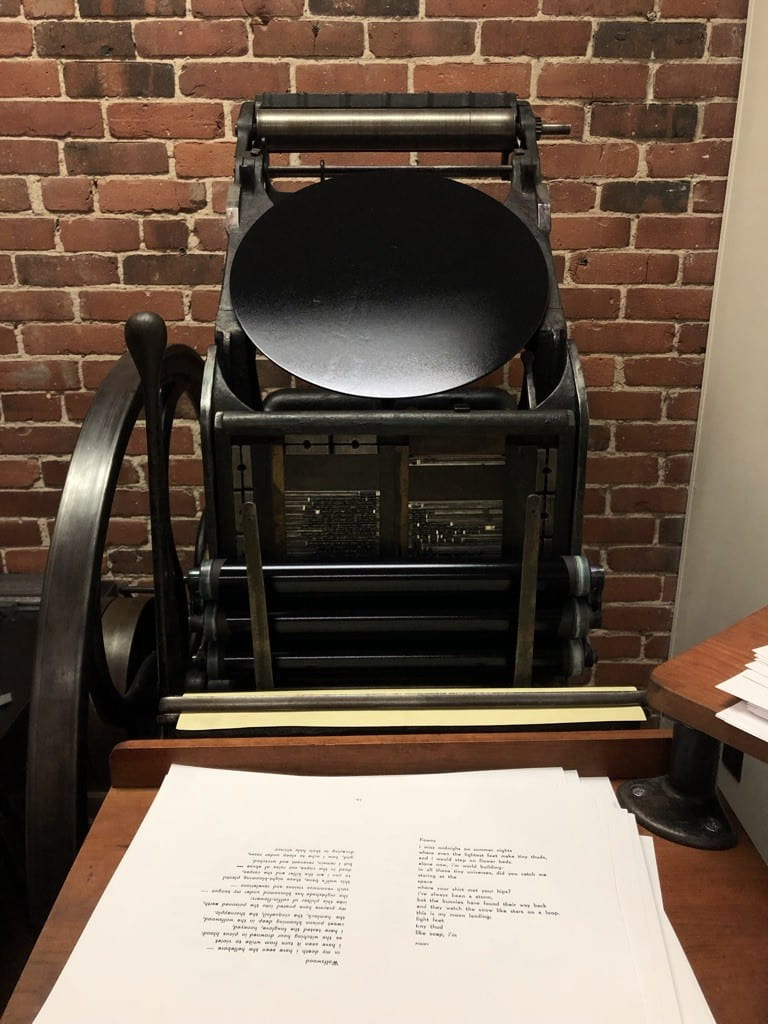
What was really interesting, and was one of the biggest take aways for us from this project was that we changed a lot of the poems as we went as we were typesetting. This was one of the most powerful things from hand setting a book of poetry is that you spend so much time setting words and punctuation, it takes so much time to set just one poem, that we really had the time to muse over our words and to see how they looked on the page and feel them out. And sometimes we would decide like this word is completely wrong we need to change it or switch up punctuation. And I thought that was really beautiful.
At this point the press didn’t have many type cases, but some of our poems were really long. So all of a sudden we would run out of e’s or periods. Sometimes we took letters from other type cases or sometimes we would have to change words or punctuation in order to keep the poem intact. That was really interesting too how the form or how the materials can shift the content.
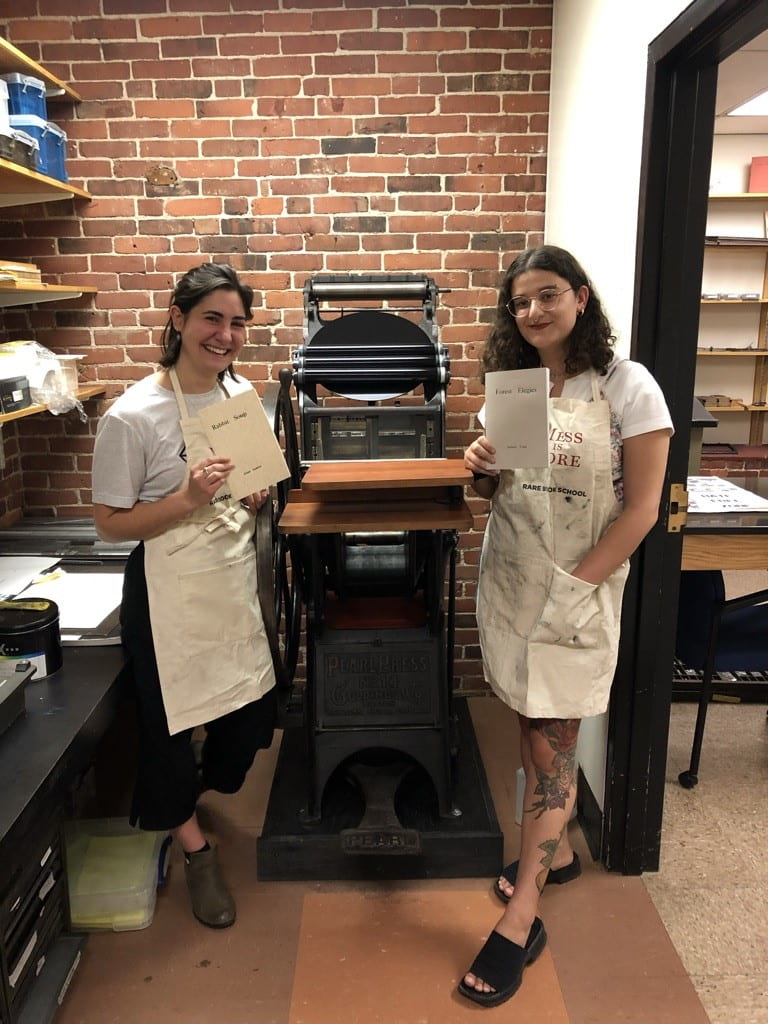
Yea it’s interesting to hear how the form restricts the content but also expands it in certain ways, like how it forces you to pay more attention, it influences it in ways that it wouldn’t if you were just writing by hand or typing.
It’s really true because like, to use a cliché, the words do jump off the page. It’s so physical, it’s so material. Honestly it’s really powerful for me. I love setting type. It’s very meditative and almost ritualistic. So you really have time to be in your headspace, spend time with this art and sort of optimize it.
Once you printed it in the printing press, how did you bind the book? Or how were you able to put the pages together into a coherent booklet?
We really struggled at first, it’s so hard to rewire your brain setting the text in the furniture of the press, because it all has to line up just right so that when you fold it, everything is in the right spot. We honestly messed up a few times. It was a learning process for all of us including Ryan, it got really intense. Because of the way we decided to structure the booklet we had to plan out the entire layout to do it upside down and mirror it.
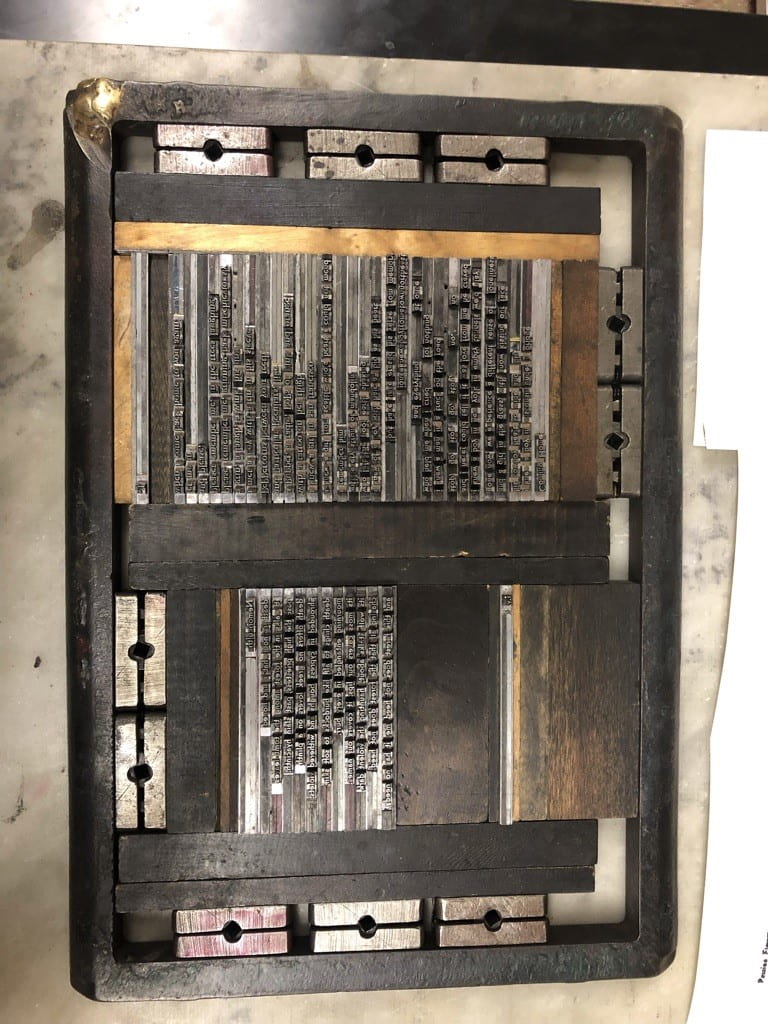
I bound all of the books by hand. We consulted someone in CAMD for guidance on like what type of thread to use, what type of stitch etcetera, but we used a three hole pamphlet stitch which is pretty simple. And I had an awl, and a needle, and twine and bone tools to bind and fold the paper, which in and of itself is its own skill separate from printing.
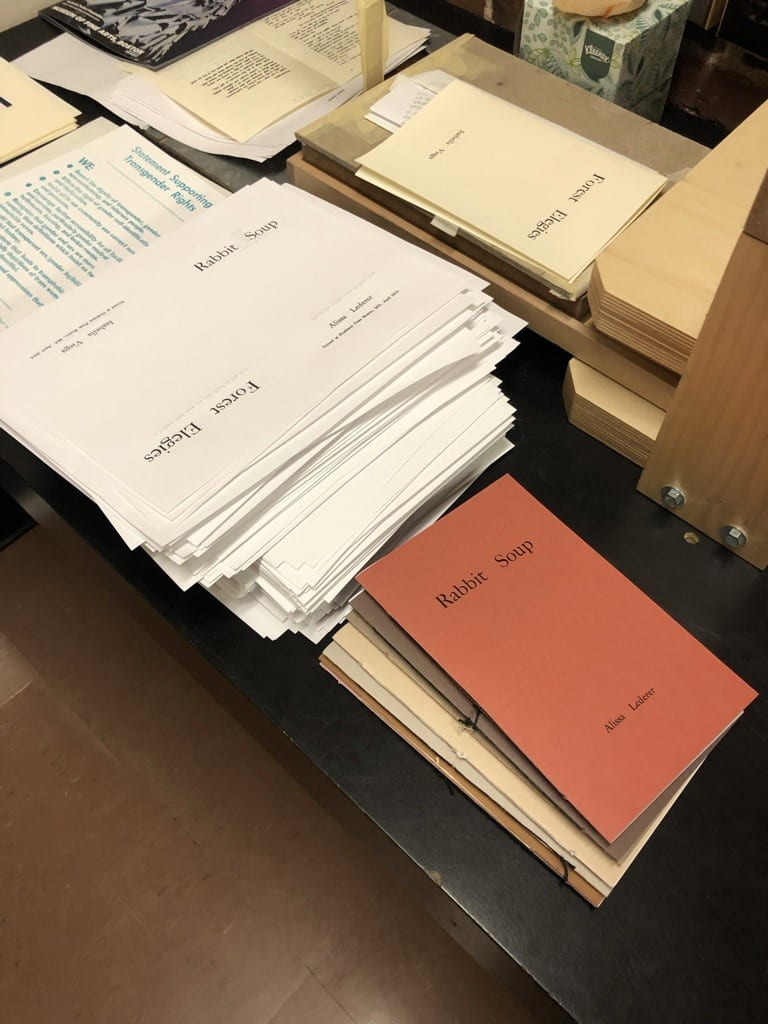
How did working at the press influence your academic interests or career path? Cause it seems like it has for you a lot, so maybe you could touch on how this project directly influenced you?
I have an edge really over most everyone in my Oxford cohort because we have a book history and material culture class, and obviously the printing press comes up a lot and the fact that I had the privilege and the opportunity to work with the press and to understand the lingo and to understand how books are really made, a lot of people don’t really have that language. Just being able to visualize how these texts were made is so valuable.
I feel like before I worked on the poetry chapbook I had a slight interest in the press and printing culture more generally, but my interest really amplified with Huskiana while working on this project. I realized the potential that creative writing has in these lost forms. For me, my poems were 100% influenced by the press. How we use print shops now is a little different because we’re operating on a really small volume, we’re doing things on a much smaller scale than the 19th century, but really print shops were meant to have a sense of collectivity. Doing this with Alissa reminded me how incredible these creative processes can be with other people, just the physicality of it.
This also has inspired my obsession with type writers. I actually donated a typewriter to Huskiana. I own like 10 typewriters.
That’s awesome
It’s horrible. I just got an obsession with movable type. I got a typewriter after I had published the chapbook, and I wrote my first poem on it and I was like “Holy s***, I never want to write a poem on a computer or with pen and paper ever again.” Just like the smells, the sounds, the feeling, it’s such a tactile experience and you get into this trancelike state that helps the creative process along. Which is why I love typewriters, it’s almost like a communion in a sense with these lost dead forms or entities.
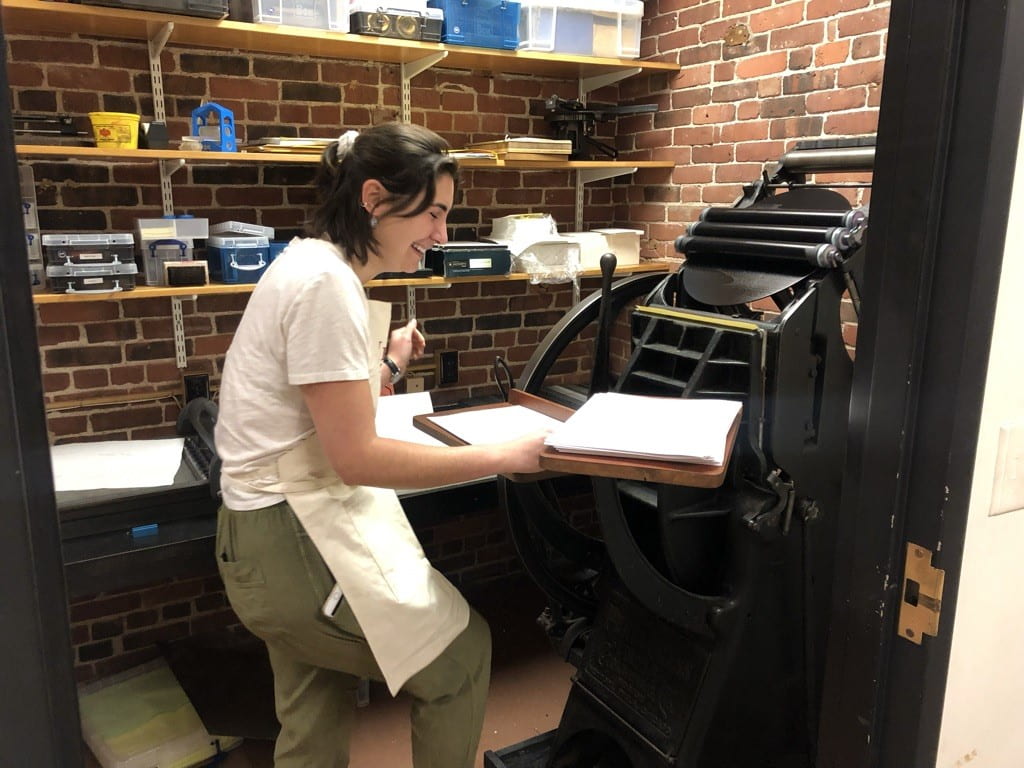
How do you see the press as a tool for people to use in the English department or in other departments at the University? How would you see it being used in classrooms or for personal use, kind of bringing that book history and tactile learning to people?
I would say like, something I’ve learned through working with typewriters is that these antiquated machines, they benefit from being used. They need to be used to function well, to remain well oiled. So like when people don’t use them, honestly it’s a detriment. They offer so much potential and they need to be used to stay alive, to be dramatic. From what I remember being at Northeastern and talking to people about the press, it seems like people are intimidated by it, because the press it honestly is pretty complicated. But I really think you can’t mess up, if you set type wrong you just fix it. If something falls you just pick it back up and resume, it’s a learning process. The printing press allows for so many art forms, you can make business cards for co-op, you can make postcards, flyers for a political issue you care about on campus, you could literally print an essay. I mean it would take time but you have full access to the shop. Alissa and I would stay up in Holmes past midnight lying on the table, eating pad thai setting type. It expands your vision and makes you feel so creative and so powerful, I recommend it to anyone. Working at the printing press was probably the best experience I had in my academic career, unparalleled. I brought my girlfriend at the time to see the press, even my mom, people are just fascinated by it. Even professors would hear us working into the evening and hear the bell dinging down the hall and peak their heads in. Everyone seems very interested in it but they don’t know how to start. Teaching students and faculty about it is a great place to start. It’s a really accessible form of technology and media, you just need a little adjustment.